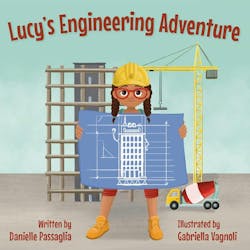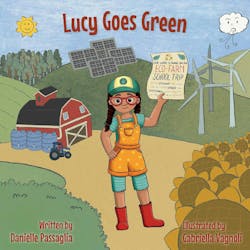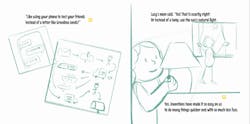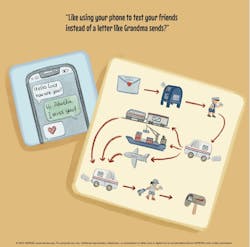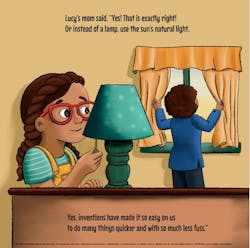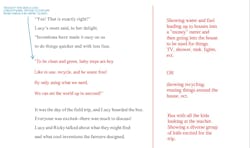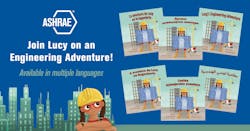How 'Lucy’s Engineering Adventure' Came to Be
By DANIELLE PASSAGLIA, PE, LEED, senior mechanical engineer
I was a senior in high school the first time I was told that engineering may not be for me.
It came from a professor at a university panel and he had made this comment without knowledge on my background, grades, or the fact that I had already been accepted into his school's freshman engineering program. That represented just the first obstacle I would face as a “potential” woman in STEM.
Occurrences like the one I experienced, however, are not uncommon. And throughout my years in the industry, I have noticed familiar trends that were marketing engineering as an “elite” club that not everyone can get into.
Indeed, engineering could be considered an elite club for women considering only 15% of working engineers are female. This statistic is not surprising to me, especially since we are discouraging young women early and often from pursuing STEM.
I was a freshman in college when our professor told us “look to your left, and look to your right… Only one of you will be here at graduation.” This would be another scare tactic to weed out young hopefuls in engineering. And it worked.
Four years later, I was a grad student when I was the only female mechanical student in my architectural engineering program. It would not be the last time I was an “only” in a room and it’s not an uncommon occurrence in our industry. In fact, a recent McKinsey workplace study indicates that 32% of women describe themselves as “onlies” in the room.
All of these experiences and data led me to the same conclusion: We needed to see a change in this industry.
Indeed, my interest in STEM outreach was sparked on that day the visiting professor told me to rethink my major. I would not let one person dictate to me what I could or could not do. I was a late bloomer in learning about engineering and STEM. So I thought if I could get into young girls' minds at an earlier age, and show them all of the unique possibilities that come with an engineering degree, I could instill in them a curiosity, a confidence, and a spark to pursue STEM... despite all the discouraging fodder they might hear along the way.
In college, I joined the Engineering Ambassadors Network. That encompassed two of my loves: engineering and talking.
With the network, I was able to visit grade schools and middle schools within my area and talk to kids about engineering, different types of engineers, what kind of jobs engineers can do, and even conduct a fun engineering exercise to help spark their interest. While many kids enjoyed making roller coasters out of pipe insulation, for example, or robotic hands out of cardboard and string, their questions were always the highlight of my visits.
For many, they had never heard of engineering beyond a train conductor. So their questions were vast and entertaining, but all had a common thread. They wanted to know if they could be an engineer. Was it attainable? “I thought you had to be really smart… Math isn’t my best subject, though… I don’t know anyone who's been an engineer… I still don’t really understand what they do…”
To each question, I’d ask in return, “Do you like to solve puzzles? Do you like asking questions? Do you like to build or create things? Because these qualities are the backbone to what makes a great engineer.”
Curiosity, creativity, and problem solving are the building blocks that make up great engineers. They are also the foundation to which I wrote my children’s book series Lucy’s Engineering Adventure.
This is the first children’s book ASHRAE has ever published, and it has become their best selling publication. Ever.
Lucy's Engineering Adventure is born
I first came up with the idea of a children’s book during a Student Activities Training session at an ASHRAE regional conference. At the time, I was the student activities chair for the Illinois ASHRAE chapter, and part of that role was to provide STEM outreach for K-8, high school, and collegiate levels. During this training, we realized there was a gap in serviceability for that K-5 range.
Despite attending STEM fairs, or going on sporadic class visits, we were very limited in what we could provide to students of that very young age. ASHRAE is a technical organization and didn’t have material to bridge that gap. With that in mind, I had suggested a children’s book might help. While my idea was well-received, the process to make it come to fruition was unknown. So, we left the training that day with no path forward to making a book happen.
I wrote my first draft of Lucy’s Engineering Adventure within three hours of that training. I had a vision for the book very quickly. I knew I wanted it to be a visual tour of the building industry taking a young girl through a building and showing her how it all works.
As a visual learner myself, I found being on site and seeing things first-hand is the best educational tool. Also, I knew that I wanted the book to rhyme. Trying to explain technical ideas to kids in an exciting and approachable way can be dry. Rhyming created an automatic cadence and rhythm that would engage and interest both child and parent while taking them through this journey with me.
- To learn more about illustrator Gabriella Vagnoli, click here.
The first book in the series takes the reader and Lucy on a site visit with her father, an engineer, where he goes on to explain how buildings work and what the systems inside a building do by personifying the building. It was a way to show the current generation of engineers, Lucy’s father, bringing and mentoring the new generation, i.e. Lucy.
Lucy goes on to discover, and learn to use her deductive reasoning to ask questions and solve problems. All of this with the overarching theme to show kids to be curious, and ask questions while learning about what we engineers in the Architecture, Engineering and Construction (AEC) industry do.
While I could have self-published, my motivation was to provide this resource for students, so I ended up publishing the first book through ASHRAE as a volunteer effort. The success of the first book gave way to demand for a second book, Lucy Goes Green.
The intent was for the first book to introduce our industry, and then to have the follow-up books describe larger concepts that we so often hear about, invloving subjects like sustainability, renewables, decarbonization, etc... I wanted those to be terms kids could understand and relate to. Hopefully, that way, as they grow older, the terms would not just become buzz words in the media, but rather be familiar, meaningful phrases describing the important topic of our impact on the environment.
Not only did I want to de-sensitize our future pipeline of engineers, but I also wanted to show young students that anyone can be an engineer now.
With that in mind, the Lucy series shows the title character as mixed race, being raised by an engineer father, and a commissioning mother. I often feel that two working successful parents aren’t depicted enough, so I wanted to challenge the norm and show both parents as technical minded and challenge those archetypes.
I also wanted Lucy to represent what we are missing in this industry. More women, and more diversity. Throughout the series, you’ll notice I challenge the archetypes not just in STEM. For instance, I wanted Lucy’s teacher to be a man since they are underrepresented in our education system today. My hope is that anyone can open the books and identify with these characters.
Admittedly, I am proud to see Lucy grace the shelves of engineers across the country, and even the world now with multiple translations. There was clearly a need for this type of series and I’m hopeful we’ll see even more interest next year, with the release of my third book, Lucy’s Carbon Footprint. (See below for a sneak peak!)
That said, I truly hope that our young readers and their parents will continue to get as much enjoyment out of this series as I do. And like me, more than a few will decide that a career in engineering really does suit them, after all.
##########
About the Author
Based in Chicago, Danielle Passaglia holds a Masters in Architectural Engineering, focused on Mechanical Engineering, from the University of Nebraska-Lincoln. She is the current president of the ASHRAE Illinois Chapter, and an energetic advocate for STEM outreach, and Women in STEM. Passaglia is the creator and author of the "Lucy's Engineering Adventure" series, which published its first children's book in 2021. (Available on Amazon and the ASHRAE Bookstore.)
About the Artist
Gabriella Vagnoli is an award-winning illustrator of multiple children's books, including three in the Cayuga Island Kids chapter book series, by Judy Bradbury (City of Light Publishing). Born and raised in Italy, she is both Italian and Brazilian and lives in Illinois. To see more of her work, go to: gabriellavagnoli.com.

